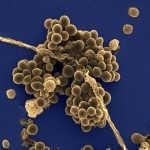Lien vers Pubmed [PMID] – 1657722
Gene 1991 Sep;106(1):21-7
We have constructed and used an integrative vector, pAT112, that takes advantage of the transposition properties (integration and excision) of transposon Tn1545. This 4.9-kb plasmid is composed of: (i) the replication origin of pACYC184; (ii) the attachment site (att) of Tn1545; (iii) erythromycin-and kanamycin-resistance-encoding genes for selection in Gram- and Gram+ bacteria; and (iv) the transfer origin of IncP plasmid RK2, which allows mobilization of the vector from Escherichia coli to various Gram+ recipients. Integration of pAT112 requires the presence of the transposon-encoded integrase, Int-Tn, in the new host. This vector retains the insertion specificity of the parental element Tn1545 and utilises it to carry out insertional mutagenesis, as evaluated in Enterococcus faecalis. Since pAT112 contains the pACYC184 replicon and lacks most of the restriction sites that are commonly used for molecular cloning, a gene from a Gram+ bacterium disrupted with this vector can be recovered in E. coli by cleavage of genomic DNA, intramolecular ligation and transformation. Regeneration of the gene, by excision of pAT112, can be obtained in an E. coli strain expressing the excisionase and integrase of Tn1545. The functionality of this system was illustrated by characterization of an IS30-like structure in the chromosome of En. faecalis. Derivatives pAT113 and pAT114 contain ten unique cloning sites that allow screening of recombinants having DNA inserts by alpha-complementation in E. coli carrying the delta M15 deletion of lacZ alpha. These vectors are useful to clone and introduce foreign genes into the genomes of Gram+ bacteria.

